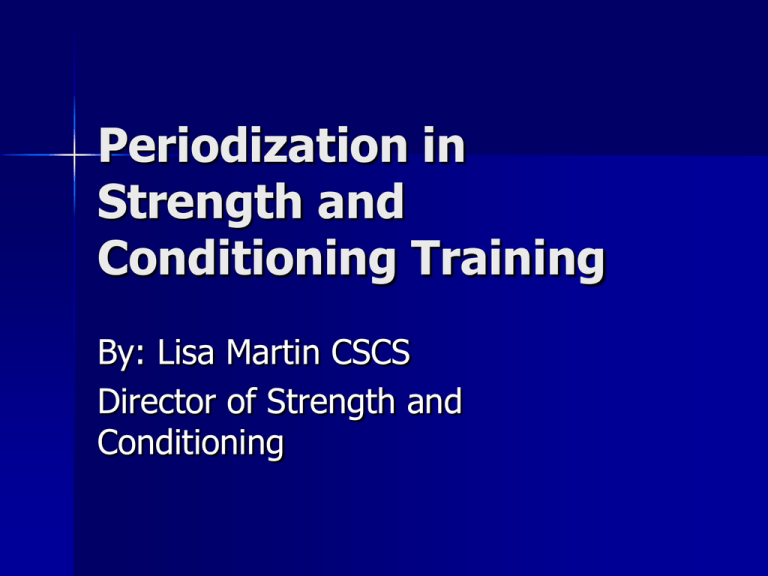Periodization in Strength & Conditioning
advertisement

Periodization in Strength and Conditioning Training By: Lisa Martin CSCS Director of Strength and Conditioning Ideas behind Periodization 1. Although training will produce positive outcomes, the desirable results can not continue indefinitely. General Adaptation Syndrome- body adapts easily Less frequent physical and psychological adaptations Plateaus, overtraining, risk of injury 2. In order to gain any particular aspect of strength or conditioning, you need to overload your system with increased external stimulus General Adaptation Syndrome (GAS) 1. Alarm- body is introduced to new or increased stress Soreness, temporary drop in performance 2. Resistance Phase- body adapts to stimulus and returns to regular functioning “super compensation”- relies on neurological adaptations to continue training while muscle tissue undergoes biochemical, structural and mechanical adjustments 3. Exhaustion- overtraining Fatigue, soreness; non-training stress may aid in leading to this stage Definition of Periodization Periodization is an organized approach to training that involves progressive cycling of various aspects of a training program during a specific period of time to bring about optimal gains in physical performance. Look Again Periodization is an organized approach to training that involves progressive cycling of various aspects of a training program during a specific period of time to bring about optimal gains in physical performance. Why do we program this way? Periodization is most widely used in resistance program design to avoid over-training and to systematically alternate high loads of training with decreased loading phases to improve components of muscular fitness (strength, strength-speed, strengthendurance) aiming to peak at the most advantageous time for an athlete Traditional Models Traditional models of periodization describes a progression from high volume and low-intensity work towards decreasing volume and increasing intensity during the different cycles. 3 Traditional Models – Stepwise periodization- a reduction in volume and an increase in intensity in steps during the training cycle – Overreaching periodization- there is periodic short term (1-2 week) increase in volume or intensity followed by a return to normal training – Undulating periodization- training volume and intensity are increased and decreased on a regular basis, but not in the general pattern of always increasing intensity and decreasing volume as the training period progresses “Various Aspects” Many training variables can be manipulated in an attempt to optimize the exercise program: – – – – – – # of sets per exercise # of repetitions per set Types, order and # of exercises per training session Rest periods between sets and exercises Resistance/Load Type and tempo of muscle action (e.g., eccentric, concentric, isometric) – Frequency of training sessions Volume vs. Intensity Intensity- the weight lifted in relationship to a maximal strength level (e.g., one repetition maximum), or a multiple repetition maximum (e.g., 10 repetition maximum). – In a running or conditioning program, intensity is often used to describe a percentage of an age predicted maximum heart rate or Vo2 max. Volume- refers to the TOTAL number of repetitions, sets and exercises performed in a strength training session – In a running session, volume refers to the total distance and/or time of a conditioning program RELATIONSHIP: – the higher the intensity, the lower the volume of a particular exercise or workout. – the lower the intensity, the higher the volume “Specific Period of Time” 1. 2. 3. Macrocyle- 1 to 4 years Mesocycle- a couple weeks to months Microcycle- 1 to 4 weeks (daily to weekly variations) Time Intervals Specific to Collegiate Athletes Macrocyle- 1 Year Mesocycle – Off Season Phase (Preparatory) – Pre Season Phase (Transition I) – In Season Phase (Competition) – Post Season Phase (Transition II) Time Intervals Specific to Collegiate Athletes, cont. Fall Sports Off Season: January-June Pre Season: July-August Competition: September-November Post Season: December Winter Sports Off Season: May-August Pre Season: September-October Competition: November-March Post Season: April Spring Sports Off Season: July-December Pre Season: January-February Competition: March-May Post Season: June Off Season Phase (Preparatory) Longest Mesocycle Emphasis: Conditioning base, correct muscle imbalances, aid in muscular endurance, develop neural adaptations to prepare athletes for increased intensity 3 Phases (Microcycles) – Hypertrophy – Basic Strength – Strength/Power 3 Phases In Off Season Hypertrophy/Endurance (1-6 weeks) – Increase anaerobic capacity, increase lean muscle mass, develop muscular and metabolic endurance base – Recovery week of low intensity/low volume afterwards – 50-75% of 1RM / 3-5 sets of 10-20 reps Basic Strength – Increase strength of muscles relative to sport, become more sport specific, heavier loads, less volume – 78-90% of 1RM / 3-5 sets of 4-8 reps Strength/Power – Explosive Training at high loads and low volume – 75-95% of 1RM / 3-5 sets of 2-5 reps Novice/Beginner Athletes Can not tolerate drastic changes in volume or intensity Linear Periodization Model: Start at lower intensities and higher volume protocols in order to condition and train neural muscular pathways May stay in low intensity training periods for a longer time Advanced/Elite Athletes Typically train closer to their abilities train at high volume and high intensity, and have smaller adaptation windows Summated Microcycle Periodization: Basic macrocyclic pattern of decreasing volume and increasing intensity is evident, but both parameters vary at meso- and microcycle levels more frequently – Increase volume and intensity each week for 3 weeks then unload for a week Pre-Season Phase (Transition I) Short duration- May only consist of 1-4 weeks of training in this phase Emphasis: sport-specific training, technique work, high intensity training/ low volume, longer periods of rest, injury prevention work, train speed, agility and quickness In Season Phase (Competition) Lasts duration of season- can be 3-5 months Emphasis: increased technique and injury prevention work, decreased volume, preserve strength if not get stronger, more explosive – Maintenance: 80-85% of 1RM / 2-3 sets of 6-8 reps – Peak: >93% of 1RM / 1-3 sets of 1-3 reps Post Season Phase (Transition II) “Regeneration Phase”- unstructured active rest cycle Short duration- 1 to 4 weeks Emphasis: non-sport specific activities, low intensity/low volume, rehab injuries, rest physically and mentally Unloading week afterwards to prepare body for increased physical demands Unloading Phases Careful not to detrain (time of interrupted training resulting in a loss of psychological adaptations) Emphasis: create less fatigue but maintain fitness levels Overall volume should be decreased, primarily by cutting out the non-specific tasks and low intensity exercises Can only happen 2 to 3 times per year and lasts anywhere between a couple days to 1 month – Shorter durations are appropriate when the preceding mesocycle involved a progressive reduction in volume/load – Longer durations needed when preceding phase involved high volume/load Frequency should be maintained at relatively high levels, 80% of normal, especially for elite athletes – During final competition phases, athletes can reduce frequency to 3050% in order to achieve large reductions in volume Progressive declines in volume produce better results than sharp dramatic drops in volume Conclusion Periodization is an organized approach to training that involves progressive cycling of various aspects of a training program during a specific period of time to bring about optimal gains in physical performance. QUESTIONS?








